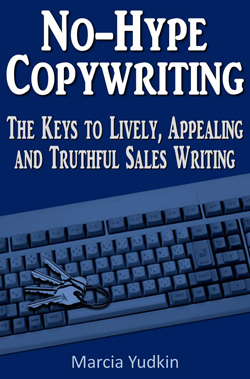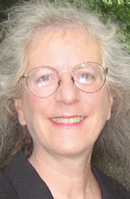Guest blogger: Marcia Yudkin
As a marketing expert, when I talk about “hype,” most people understand that I’m referring to an overexcited style of writing, as if from a loud, aggressive person standing outside a circus tent. Hype features lots of exclamation marks, hot-and-bothered promises and warnings not to miss the best whatever since the beginning of time.
As a visual artist, you probably aren’t a word person. You may lack the instinct to notice the difference between hype and a more honest and effective style of using words.
 If you hire someone to create the text for your website, you may not like their tone but get intimidated when told that that’s what will get you attention from the most readers. Or you may believe all marketing is hype, and therefore you shudder at the very idea of putting together words to attract buyers or gallery owners.
If you hire someone to create the text for your website, you may not like their tone but get intimidated when told that that’s what will get you attention from the most readers. Or you may believe all marketing is hype, and therefore you shudder at the very idea of putting together words to attract buyers or gallery owners.
So I’d like to offer some help in understanding why and how you might want to keep hype at arm’s length.
Hype is more or less randomly chosen hot air, and therefore it isn’t specifically about you. It’s emotive and uninformative.
To some onlookers, it lowers your value to the level of the National Enquirer. Unless you have a campy or mass-market aesthetic, you and your art are best served by avoiding hype.
When you reject hype, you set the stage for better appreciation of what you’re actually up to in your art. [Tweet this.] People who become interested in your work with tuned-in expectations are more likely to stay interested and tell others about it.
Here, then, are some elements of hype to look out for in your customer emails, press releases, blog posts, tweets and your website – and what to substitute for them.
Emotion Without Content
Watch out for empty adjectives, such as “special,” “wonderful,” “lovely,” and their contemporary counterparts, like “awesome,” “epic,” or “killer.”
These convey praise but otherwise don’t really say anything. Therefore such words aren’t helpful to you.
If you find empty adjectives in what you wrote about yourself, your work or another artist you admire, choose more specific adjectives.
What was lovely about the work? What exactly did you find awesome about the show? Or try rewriting using no adjectives at all, just nouns and verbs.
Breathless Gushing
When you’re excited, it’s tempting to express that feeling with exclamation points, and maybe even more than one of them at the end of your sentences. Ditto for enthusiastic babbling, like “Oh my gosh” or “OMG.”
However, people take you more seriously when you get rid of nearly all of the exclamation points and cut the squealing.
Exaggeration and Boasting
It isn’t boasting to say verifiably true things about yourself or your art, such as “award-winning fiber artist” or “sculptor whose work has been widely exhibited.”
But beware of describing yourself or your work with qualities that are normally left for others to judge, such as “inspiring,” “profound” or “humorous.” [Tweet this.]
Avoid all superlatives (words ending in “-est”) unless you’re quoting a critic, review or media story.
Sheer Anticipation
If you’re unveiling new work in the near future or looking forward to an installation or exhibition, by all means let people know. Announce what will happen when. A little drumroll is fine.
Just don’t play a teasing game of “Something’s coming October 17 – stay tuned to find out what it is!” Everyone except your very closest buddies will consider that hollow hoopla.
When in doubt, use simple, straightforward words and phrases. Be conversational and down to earth. Sincerity appeals to people more than hype does!
About Our Guest Blogger

Marcia Yudkin is a copywriting and branding expert and the author of 6 Steps to Free Publicity, now in its third edition, along with 16 other books.
Her e-book No-Hype Copywriting: The Keys to Lively, Appealing and Truthful Sales Writing is available on Kindle, Nook, Smashwords and Audible.
Marcia invites you to the No-Hype Copywriting Telesummit. Telesummit has passed. Now available for download.



6 thoughts on “Avoiding Hype in Your Art Marketing: Why and How”
Great professional advice, Marcia. What do you think about what person to write in? I was always taught it is better to write in 3rd person, rather than 1st person narrative, yet with a blog or website it is essentially a narrative. What is appropriate for which materials? Thank you.
I actually just went to Amazon and her books look really nice and helpful. Thank you for introducing Marcia Yudkin.
Lady: Marcia is wonderful. Her books are loaded with excellent advice and good stories. I found her through her book “6 Steps to Free Publicity” years ago.
I write in the 1st person but remove as many I’s and Me’s as possible. Go for fact and a brief explanation of why. eg I use a fineliner for pen work because it is entirely predictable… A bit of quirkiness is okay, the sentence finishes with “and doesn’t have a mind of it’s own.” I totally agree with Marcia, very sensible post to share.
A great post, and so important. I’d add to please use grown-up language. And sorry, but that goes for this site too; I cringed at the lead post full of “yay! boo!” after eagerly clicking to see what Alyson had to say on her topic. I’m not six, and I don’t want to be talked to or written to as if I were. I see this on craft and mixed media blogs incessantly, and more than I’d like on serious art blogs. Don’t use diminutives for professional writing; say vegetables, not veggies, and congratulations, not congrats. Also, Evelyn above, it should be “and doesn’t have a mind of its own.”
I don’t agree that visual artists are not word people. Many people are both. If you’re not skilled with words and writing, hire an editor; we’ve spent years and years getting good at what we do, too.
” Unless you have a campy or mass-market aesthetic, you and your art are best served by avoiding hype.” Ok, so I fall into this early disclaimer…I am camp…Which also translates into mass market because camp has a wide underground appeal…Gert Boyle the founder of Columbia Sportswear is camp too…So I’m on the fence…I do agree with wearing grown-up pants, understating rather than overstating, low key rather than high key…I also love you Marcia Yudkin & have been following along peripatetically for years…(Didn’t make it to Hawaii though)…What I wonder is this:Are women artists baby-fying their language due to misogynistic influences, or is this an organic sprout from the desire to retain the automatist-child within naivete, the speak as a child on purpose edict that we all learned from early prayer lessons? or are we just abbreviating from vegetables to veggies because we have run out of space?